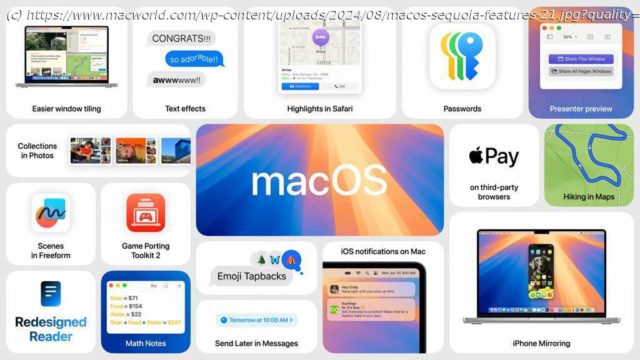Here’s what you need to know about the next macOS. Find out about macOS 15 Sequoia, including when the new macOS 15 will be out, compatibility, new features, and the latest beta info.
Following the WWDC keynote on June 10, we now know that the next version of macOS will be called Sequoia, named after the Californian National Park. Among the new features coming to Macs are iPhone mirroring, which puts your iPhone screen on your Mac’s display and lets you interact with it via your mouse and keyboard, a new Video conferencing presenter preview, and changes to Safari. In addition, developers will be easily able to port games between iPhone, Mac, and iPad. Read on for the lowdown on all the new features and improvements coming later in 2024.
This free software update will bring a raft of interface tweaks, bug fixes, and new features. In this article, we discuss everything you need to know about macOS 15. Some new features are reserved for Macs with an M-series chip. Apple also showcased a number of Apple Intelligence features that will offer help with writing, creating images, editing photos, and more.
The developer beta was released on June 10 and we will discuss the latest versions of the beta and how to get your hands on that below and in separate articles. We will also explain when the final version of macOS 15 will come out, how to get it when it does, which Mac models will be able to run macOS 15, and the features that will be added in the new OS.
Update August 23, 2024: Apple may release macOS Sequoia in mid-September along with the iOS 18 release, according to a report.macOS 15 name: What will the new version be called?
Ever since Apple stopped using the names of jungle cats with macOS 10.9 Mavericks, it’s used California places to identify its annual OS updates. The last several years have been Sonoma, Ventura, Monterey, Big Sur, and Catalina. Apple has trademarked several other place names, including Condor, Mammoth, Redwood, and Sequoia – so the name Sequoia was expected to appear at some point and indeed it has.
macOS 15 Sequoia is named after the national park in California, home to mountains, canyons and the world’s largest trees. macOS Sequoia release date
The final version of macOS 15 will be released to the general public in the fall. In the recent past, the release has come several weeks after the new version of iOS ships, although in 2023 the macOS release came sooner than was usual. Here are the release dates for the previous five versions of macOS:
macOS 14 Sonoma: September 26, 2023
macOS 13 Ventura: October 24, 2022
macOS 12 Monterey: October 25, 2021
macOS 11 Big Sur: November 12, 2020
macOS 10.15 Catalina: October 7, 2019
macOS 10.14 Mojave: September 24, 2018
As in 2023, we may see macOS 15 arrive in September, around the time of iOS 18, possibly September 23. But we may be waiting until late October, perhaps October 21, 2024 for the launch.
According to MacRumors, Apple is planning to release macOS Sequois in September, at the same time as iOS 18.
Once the final release comes out, installing macOS Sequoia will be a breeze. Open System Settings and go to General > Software Update; macOS will check for any available updates and guide you through the process of installing them. You simply have to follow the instructions, which we explain in our macOS updating guide. And it’s easier still if you’ve turned on Automatic Updates, which you can do from the same screen. macOS Sequoia beta: latest versionDeveloper beta
Apple began the beta program soon after it revealed the details of macOS 15 at WWDC. The developer beta is available for anyone who wants to run it, but it should be noted that this early beta is very likely to be buggy, so we don’t recommend installing it on a primary device. Read: How to install the Mac beta.
The second version of the developer beta arrived on June 24. This version brought iPhone Mirroring–the ability to access an iPhone through a Mac. (See the new features section below for more details).
The third developer beta arrived on July 10. The macOS Sequoia 15 developer beta 4 was released on July 23. Developer beta 5 was released on August 5. Developer beta 6 was released on August 12.
On July 29, Apple jumped to macOS Sequoia 15.1 beta and introduced some Apple Intelligence features. This is because the initial launch of macOS 15 Sequoia will not include AI features.
On August 12, Apple released the macOS Sequoia 15.1 beta 2. It is a developer beta and will only run on M-series Macs.
For developers working on the iOS 15 beta Apple released iOS 15 beta 6 on August 12.
Note that a report by 9to5Mac states that Apple Intelligence will not run if the 15.1 beta is running on an external drive. It’s not known if this condition will remain when Apple officially releases 15.1.
On August 20, Apple released the macOS 15 beta 7 to developers.Public beta
Running alongside the developer beta is a public beta. Public beta testers can’t try out the Sequois 15.1 beta (unless they sign up for a developer account), but Apple is running a macOS Sequoia 15 public beta.
Apple released the macOS Sequoia public beta on July 15, 2024. In 2023 Apple Apple released the first public beta of macOS 14 on July 12. The second update to the pubic beta came on July 23, 2024 and the third on August 6.
Apple released the Sequoia public beta 5 on August 20, 2024.
The beta testing will continue even after Apple releases macOS Sequoia to the general public as Apple develops new features not available at launch.How to install the macOS beta
If you want to install the developer beta, you need to be a registered Apple software developer, which has both free and paid ($99/£79) versions. Since June 2023 Apple has opened the beta to all registered developers–so now everyone can get the earliest possible access to the macOS beta without paying a penny.
Home
United States
USA — software macOS 15 Sequoia superguide: Everything you need to know about the Mac...






